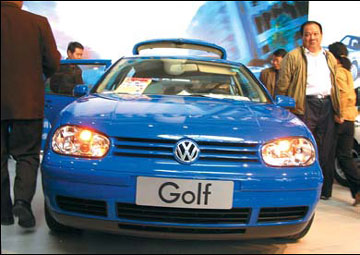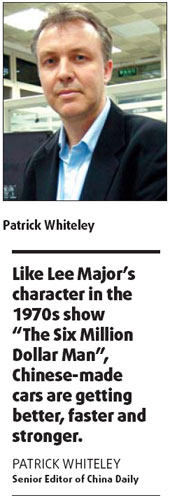Better, faster, stronger
A senior foreign correspondent has been covering China on and off for more than 20 years and during this time has bought four cars. Before he purchased his latest ride - a 1.8-liter VW Golf - all of his buys were lemons. There were constant breakdowns, parts kept falling off, and after-sales service was sorely lacking.
But for more than a year now, his 160,000-yuan made-in-China Volkswagen has been running like a dream. The Golf is a great little car. Its solid build, classy styling inside and out, and terrifically weighted steering are just a few of the reasons why it's a winner.
The award-winning journalist, who holds back no punches covering China issues, says his local Beijing VW dealership's after-sales service has also been excellent. He says there has been a dramatic overall improvement.
My learned friend remembers visiting VW's factory in northeast China about a decade ago, a time when most parts were imported and cars were only assembled in China. He noticed signs on the factory wall signaling the goal of sourcing parts locally. VW's mission at this factory has been accomplished and the all-important service area is following suit.
Like Lee Major's character in the 1970s show "The Six Million Dollar Man", Chinese-made cars are getting better, faster and stronger.

A huge market
Last year China overtook Japan to be the second-largest car market in the world and this year new auto sales are expected to hit 10 million, but we ain't seen nothing yet.
For every 100 Chinese there are only six car owners, compared to 90 percent car ownership in the US. Research company AC Nielsen discovered that China also has more aspirational car buyers than any other nation. Can you imagine when two and three car families start to emerge?
With such a huge domestic market to supply, Chinese car makers and their foreign partners are busier than a Chongqing bricklayer.
The China market is unique because buying a car is a totally new experience for the majority of Chinese families.
My first ride was my mother's humble Datsun 180B. I was only 17 but it my ticket to freedom. I used the little four-cylinder to explore Australia's New South Wales coastline and surf to my heart's content with my friends in tow. Over the following decades, I've driven a bevy of beautiful cars, some shockers, a few motorcycles, and also few big 16-wheel trucks. I have almost a quarter century of driving experience behind the wheel, which is about normal for a 41-year old in most Western countries.
This type of middle-aged driver has a higher level of motoring appreciation and knows what he or she likes. We can see through the smoke and mirrors of a slick advertising campaign because in the end, it's all about the car.

We want a car that delivers power and performs well on the highway and in city traffic. Fuel economy is important considering the price of gas and good gadgets are an important part of the deal. Quality sound systems, aircon, and these days GPS are must-haves. We also want the best safety options.
In China, many first car owners are in their mid-30s. Some are only starting to drive at my age. Considering the 2,500-yuan monthly salary of many white-collar workers, it takes time to accumulate enough money for a deposit on a 160,000-yuan plus new car. Now millions of Chinese motorists are upgrading to their second car and a used-car market has emerged providing lower-cost options for entry-level drivers.
Second car buyers now have experience and are more discerning. They are not as impressed by the flashy marketing campaigns as they once were. They read the new auto magazines, watch the TV car shows and are warming to certain brands.
Like mature drivers in the West, modern Chinese motorists realize it's all about the car and the Chinese auto market, like all successful markets do, is bending to the needs of the customer. Putting it simply, Chinese cars are getting better.
Before Chinese cars can conquer Western markets, like the Japanese and Korean brands have done, they first must master their own, and the VW Golf is an encouraging sign. Now the question is not whether a Chinese-designed and made car will do it, but when.
Domestic players
Chery is leading the way and has inked a deal with Chrysler to supply a small car. Chrysler's new China boss Phil Murtaugh, who was poached from Shanghai Automotive Industry Corp last year, says the US campaign is still two years away but has shifted the company up another gear.
Recently Chrysler rushed top engineers to Chery's factories in Wuhu to help raise quality levels among its vehicles as part of its US assault strategy, which involves Chery cars re-badged as Dodges or Chryslers.
Lifan is another pioneer. After passing the Russian crash test, and winning European E-mark accreditation, Lifan is planning to export cars to the US in 2010, with the goal of selling them the following year.
Led by Chairman Yin Mingshang, a former farmer who does not forget his roots, Lifan is planning to modify the Lifan 520's emissions and safety gear to meet US regulations. US road testing is reportedly already underway.
British company Ricardo has also helped Lifan with its 1.3-liter engine range and negotiations are underway to produce an automatic gearbox.
Yin announced that Lifan had registered a sales company for the equally competitive German market and plans to set up factories in Eastern Europe and Southeast Asia. The plan is to sell 150,000 cars annually in overseas markets over the coming years.
Besides quality design and build, safety is another big issue for ambitious Chinese manufacturers because standards are not nearly as strict as they are in America. Chinese car companies also don't face whopping big personal injury lawsuits as their US counterparts do.
While local companies are looking outward, foreign companies, especially the struggling US auto giants, continue to look for opportunities in the Middle Kingdom.
General Motors is expanding its operations in Liuzhou to produce a tiny minivan, the Wuling Sunshine, which sells 460,000 units a year. The $3,800 minivan has a 0.8-liter engine and can reach 100 km/h.
Rather than using modern automation, the Wuling Sunshine is made on a 1950s-style assembly line and labor costs are reportedly only $100 per unit. GM makes significant profit on each vehicle to help recover losses elsewhere.
At the other end of the technology spectrum, foreign companies are boosting their research and development centers, which could help innovate the next great advances in the auto world, especially in green technology.
China has been criticized for its environmental record, but wouldn't it be ironic if the world's cleanest engines were soon made here?
The government is spending billions of dollars to improve the environment, and has named car exhaust emissions as a major offender. Because of the urgent need, China's auto makers, with help of the world's best motoring engineers, may speed up this area of research and development faster than others.
Considering that 94 out of 100 Chinese do not have a car and most want one, the industry needs to continue to improve like the Six Million Dollar Man.
Gentlemen, we have the technology.
(China Daily 04/18/2008 page21)














